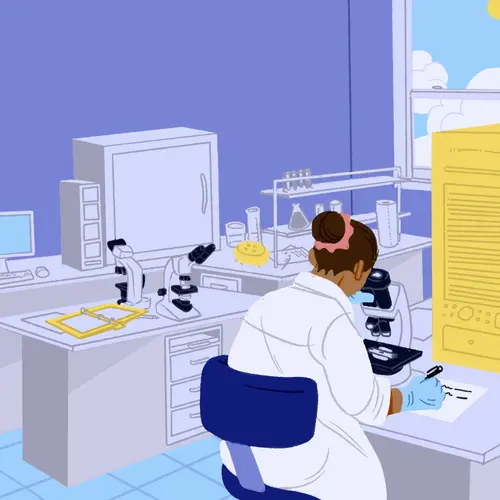Multiple myeloma – a rare form of blood cancer – is usually found in people 65 and older. While it’s rare in young adults, a small percentage of people 19-40 also have the disease.
Only 10% of people diagnosed with multiple myeloma are under 50, and 2% of people are under the age of 40.
Some people are diagnosed when they go see a doctor for symptoms. Others are diagnosed when they go for routine blood work, urine, and other tests, and doctors spot things that are out of the ordinary.
While there isn’t a cure for multiple myeloma, there are a variety of treatment options, depending on how severe the disease is and its stage. Many young people with the disease are successfully treated and live for decades without it coming back.
Differences in Multiple Myeloma for Young Patients
Multiple myeloma can have different symptoms in people of all ages. Doctors are not sure why the disease can be slow to get worse for some patients and more aggressive for others, regardless of age.
But studies have shown that younger patients tend to be diagnosed with forms of the disease that get worse more slowly.
Due to the early stage of the disease and general stronger health of younger patients, many can often withstand more intense treatments. For example, one study showed that younger patients were about twice as likely to have high-dose therapy, compared to older patients.
As a young patient, you are also more likely to need multiple types of treatment throughout your lifetime, for maintenance or to treat the disease again if you relapse. The types of maintenance and relapse treatments will depend on the stage and type of disease, as well what treatments you’ve had already.
New treatments and drugs are being discovered and explored, so as a young adult, you are more likely to have a chance to try new drugs or treatments to see if they help maintain, slow down, or manage the disease.
Long-Term Concerns for Younger Patients
Young patients with multiple myeloma tend to live longer than older patients with the disease. Since young patients are successfully treated and go into remission, they are at a higher risk for survivorship issues, or complications due to the disease and/or treatment. These issues can include infertility, reproductive concerns, other cancers due to the disease or treatment, and the ability to follow long-term treatment guidelines.
As a young patient with multiple myeloma, it can be tough to deal with the fact that even if the cancer is in remission, it may come back. Regular tests, doctor appointments, and maintenance therapy also become a routine part of life.
Talk to your doctor if you need help coping with the mental, physical, or daily challenges of living with multiple myeloma. They can recommend or connect you to services, programs, and support groups that may help.
Treatment Options for Young People With Multiple Myeloma
Many drugs and therapies can treat multiple myeloma. The type of treatment your doctor recommends will depend on the stage of your disease, your overall health, and how aggressive your disease is. But as a young person with multiple myeloma, the goal will be to get you a stem cell transplant. This treatment provides the longest survival.
In general, young patients may benefit from more aggressive therapy at first diagnosis, such as high-dose chemotherapy or a stem cell transplant. But your doctor will consider your specific disease situation and health to determine the best course of action for you.
The goal of treatment and therapy is to achieve complete remission, where there are no signs and symptoms of the disease, and to keep you in remission as long as possible. If they cannot achieve complete remission, doctors may recommend treatments to ease pain and symptoms, and increase your quality of life.
Treatment options include:
- Medications to manage bone pain and discomfort
- Antibiotics to treat any infections, which can be common due to a weaker immune system
- Immunotherapy to help boost your immune system to fight the cancer cells
- Radiation to kill cancer cells and tumors
- Chemotherapy to reduce the number of abnormal cancer cells
- A stem cell transplant, where doctors replace damaged or unhealthy stem cells with healthy cells from your body, or, if needed, from a donor. First, they harvest the healthy cells and then kill off the unhealthy cells with chemotherapy, which can take place for 3 to 4 months. Then, doctors put – or transplant – healthy cells into your body. Not all patients are eligible for this treatment.
When figuring out which treatment is right for you, your doctor may first determine whether you are eligible for a transplant. Then, they will consider how aggressive your disease is.
Many patients have different treatments throughout their lifetime, to manage the disease if it comes back.
Who Else Is at Risk for Multiple Myeloma?
More men than women are diagnosed with multiple myeloma, and African Americans are more than twice as likely to have the disease than white people. Asian Americans are less likely to have it than white people, but the reasons for these differences are not known.
The average age of a patient diagnosed with multiple myeloma is 66, but as mentioned, there is a small group of young adults with the disease. Younger patients are more likely to be diagnosed at an early stage of the disease and less likely to be first diagnosed with stage II or stage III.
While the cause of multiple myeloma is unknown, researchers are looking into connections between the disease and genetics and exposure to toxic chemicals, such as pesticides and Agent Orange.

